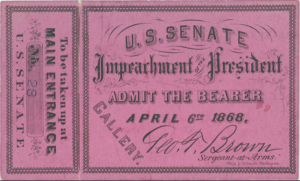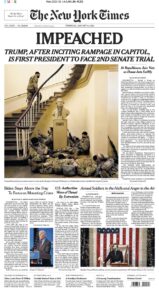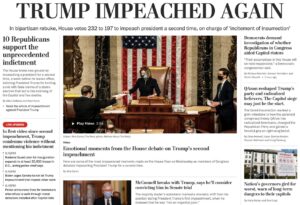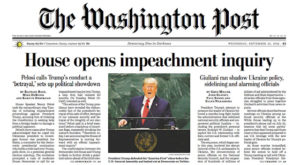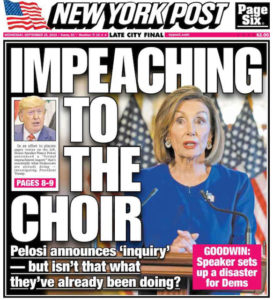Impeachment
X2
January 13, 2021Time to put on your big boy pants, Mitch.
232-197
“No president has ever had so many members of their own party vote to impeach them.”
-Young journalist Gabe Fleisher
https://www.wakeuptopolitics.com
From an overnight streaming post on social media from Rep. Alexandria Ocasio-Cortez, speaking to the nihilism of white supremacist violence:
“What claim will you have? That you rule over a destroyed society? That the ashes belong to you?”
‘When black people and their allies exercise freedom of speech, it is called violent insurrection. When white racists carry out violent insurrection, it is called free speech.’
Members of the National Guard rest below the iconic painting of our first president, on the day Congress impeached the 45th.
And the headline we never got to see.
Jay Rosen: asymmetrical polarization
December 18, 2019is a media critic, writer, and a professor of journalism at New York University. Rosen is a contributor to De Correspondent and a member of the George Foster Peabody Awards[1] board of directors.
The Media Today
“Both sides”
By Jon Allsop, CJR
As impeachment has progressed, attacks on the “both sides” approach—and the Times, in particular—have intensified. Over the weekend, critics trained their ire on an article in the paper, headlined “The Breach Widens as Congress Nears a Partisan Impeachment,” about a debate in the Judiciary Committee. Nate Silver, of FiveThirtyEight, noted that the actual words “both sides” appeared four times in the piece. (One of these was in a quotation.)
As impeachment has progressed, attacks on the “both sides” approach—and the Times, in particular—have intensified. Over the weekend, critics trained their ire on an article in the paper, headlined “The Breach Widens as Congress Nears a Partisan Impeachment,” about a debate in the Judiciary Committee. Nate Silver, of FiveThirtyEight, noted that the actual words “both sides” appeared four times in the piece. (One of these was in a quotation.) Jay Rosen, a journalism professor at NYU, listed 12 more snippets from the article as evidence of the Times’s inability to handle what he calls “asymmetrical polarization.” They included “the different impeachment realities that the two parties are living in,” “both sides engaged in a kind of mutually assured destruction,” and “the two parties could not even agree on a basic set of facts in front of them.”
Rosen is right that this sort of language is inadequate: Democrats, for the most part, are engaging with the factual record; Republicans, for the most part, are not. These positions are manifestly not equivalent. Treating them as such does not serve any useful concept of fairness; instead, it rebounds clearly to the advantage of the one side (Republicans) for whom nonsense being taken seriously is a victory in itself. The Times is far from the only culprit. The structure of some TV news shows, in particular, has bothsidesism hardwired into it: a Democrat and a Republican are given equal time to make their unequal impeachment cases, and both face hard questions, to contrive a sense of balance. The questions lobbed at Democrats are often fair, but often pale into triviality when a Republican follows them on and starts sowing conspiracy theories.
When it comes to much impeachment coverage, bothsidesism isn’t the beginning and end of the problem, but part of our broader reflex to frame contentious political stories around the concept of partisanship. In parts of the press, a set of party-oriented impeachment narratives has taken hold that contains some truth, but also rests on a selective interpretation of available evidence. Entrenched partisanship—in Congress and the country—is real, and newsworthy, as is the role that our fragmented information ecosystem has played in stoking and reinforcing division. And yet it does not follow, as some journalists and pundits seem to have surmised, that impeachment has been a waste of time. At the beginning of his show yesterday, Todd said the “national response” to impeachment has been “whatever.” And yet, as I wrote earlier this month, support for impeaching DT, while recently static, is historically high. (A Fox News poll out yesterday reinforced that finding.) Six Republicans in Michigan are not the country.
The media’s job, done properly, is multidirectional: it holds power to account, and communicates matters of public interest to news consumers. On impeachment, too much coverage seems to have got stuck in a feedback loop: we’re telling the public that politicians aren’t budging from their partisan siloes, and vice versa, with the facts of what Trump actually did getting lost somewhere in the cycle. The cult of “both sides” is integral to this dynamic, and it’s serving the impeachment story poorly. Now, more than ever, our top duty should be to fight for the truth.
https://www.cjr.org/the_media_today/both-sides-impeachment-trump.php
The Breach Widens as Congress Nears a Partisan Impeachment
Fleeting efforts at persuasion by members of the Judiciary Committee gave way to disputes over basic facts during a marathon debate over articles of impeachment.
Partisan & Destructive
December 9, 2019NYTIMES
Paul J. McNulty, Deputy Attorney General during the George W. Bush administration & the chief counsel and spokesman for the committee Republicans, and now a college president, said the fight over impeachment had gone from “partisan but constructive” in 1998 to “partisan and destructive” now.
“That dynamic had the potential to damage the nation’s politics for years, and could permanently alter the intent of the authors of the Constitution.”“My hope would be, as a citizen, that when this is over, somehow, some way, we could stop and think about what impeachment was meant to be for.”
“In a deeply polarized nation where party rules above all else, a process enshrined in the Constitution as the most consequential way to address a president’s wrongdoing has devolved into another raucous partisan brawl.”
https://www.nytimes.com/2019/12/08/us/politics/impeachment-partisan-democrats-republicans.html
[Jay Rosen, press critic, writer, and professor of journalism]
‘…the idea of democracy.’
December 8, 2019Photograph by James Marabello / Alamy
By Jill Lepore
The Impeachment Hearings and the Coming Storm
New Yorker
The madness of the moment lies in looking at how this came to pass, at how many people had to give up on the idea of democracy for things to come to this.
Almost always, I bite my tongue. But, yes, he is that bad, and this is unprecedented, and these acts are impeachable, and, if it seems as though people have been clamoring for his impeachment since he took office, that’s only because he has behaved abominably since he took office. Is abomination impeachable? No. But the abuses of office of which the President now stands accused are the very definition of impeachable.
The madness lies in looking, honestly, at how this came to pass, at how many people had to give up on the idea of democracy for things to come to this. The sadness lies in the recognizing of the unlikelihood of anything getting much better anytime soon, what with the slush and the sleet and the coming storm. A farmer walks across a field, bracing against the wind. Hardness is what’s required to get through a political winter: determination, forbearance, sacrifice, not bitterness but a certain sternness.
https://www.newyorker.com/news/daily-comment/the-impeachment-hearings-and-the-coming-storm
History.
September 25, 2019
| A lesson from 45 years ago… |
 On April 29, 1974, President Richard M. Nixon points to the transcripts of the White House tapes after he announced during a nationally-televised speech that he would turn over the transcripts to House impeachment investigators. Photo: AP
“As a junior aide in President Richard Nixon’s White House, I saw congressional oversight and investigation command immensely greater power and respect than it does today,” Jonathan C. Rose — special assistant to Nixon from 1971 to 1973, and associate deputy attorney general from 1973 to 1975 — writes in The Atlantic. “As evidence implicating the White House mounted, the administration displayed no inclination toward negotiation or accommodation with the Senate Watergate Committee. On March 15, 1973, Nixon issued an edict asserting executive privilege, declaring that White House aides and papers were entirely off limits to the committee. If the committee desired to press the issue, the president said, it could pursue a contempt prosecution through the courts.
“Pressed for his reaction, [Senate Watergate Committee Chairman Sam] Ervin said Nixon’s position was ‘executive poppycock, akin to the divine right of kings.’ Ervin declared that his committee had no intention of submitting to the suggested judicial delays, but would instead utilize the Senate’s sergeant at arms to arrest any recalcitrant White House aide, bring him to the bar of the Senate for trial, and ultimately compel him to testify.
“As damaging revelations continued to mount and the stigma of cover-up gathered strength, the White House floated trial balloons, offering the Watergate Committee possible closed-door interviews with White House aides. …
“By mid-April 1973, Nixon’s resistance to testimony by White House aides had collapsed, and a number of them testified. This testimony disclosed the White House taping system and confirmed the existence of tapes. Those disclosures ultimately led to Nixon’s departure from office.”
-AXIOS
|
